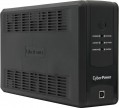Switching to battery
The time required to transfer the load from mains power to battery power. In standby and
interactive UPSs (see Type), a short-term power failure occurs at this moment — accordingly, the shorter the time to switch to the battery, the more uniform the power supply is provided by the source during a power failure. Ideally, the switching time for the traditional 50 Hz AC frequency should be less than 5 ms (a quarter of one cycle of the sine wave). With inverter UPSs, the transfer time is, by definition, zero.
Input voltage range
In this case, the input voltage range is implied, in which the UPS is able to supply a stable voltage to the load only due to its own regulators, without switching to the battery. For redundant UPSs (see "Type") this range is quite small, approximately 190 to 260 V; for interactive and especially inverter ones, it is much wider. Some UPS models allow you to manually set the input voltage range.
Max. current
The maximum current drawn by the UPS. In fact, the current reaches its maximum value only when the UPS is operating from the mains with maximum load power and a completely discharged battery. However, when calculating the load on the power grid, this parameter should be taken into account.
Input frequency
The operating frequency of the alternating current supplied to the input of the UPS — or more precisely, the frequency range of this current in which the device can supply the required power to the load due to its own regulators, without using a battery. When this range is exceeded, the UPS switches to battery mode. The smallest input voltage range is reserved for standby UPSs (see "Type"), the largest for inverter UPSs.
Max. output power
The maximum output power supplied by the UPS, in other words, the highest apparent load power allowed for this model.
This indicator is measured in volt-amperes (the general meaning of this unit is the same as that of the watt, and different names are used to separate different types of power). The total power consumption of the load, implied in this case, is the sum of two powers — active and reactive. Active power is actually effective power (it is indicated in watts in the characteristics of electrical appliances). Reactive power is the power wasted by coils and capacitors in AC devices; with numerous coils and/or capacitors, this power can be a fairly significant part of the total energy consumption. Note that for simple tasks, you can use data on effective power (it is often given for UPS — see below); but for accurate electrical calculations it is worth using the full one.
The simplest selection rule for this indicator is: the maximum output power of the UPS in volt-amperes should be at least 1.7 times higher than the total load power in watts. There are also more detailed calculation formulas that take into account the characteristics of different types of load; they can be found in special sources. As for specific values, the most modest modern UPSs give out
700 – 1000 VA, or even
less — this is enough to power a PC of average performance; and in the most "heavyweight" models, th
...is figure can be 8 – 10 kVA and higher.Redundant sockets
The number of
outlets connected to the power reserve(battery) provided in the design of the UPS. In order for the UPS to fulfill its main role (providing a backup power in case of power outages), the corresponding electrical appliances must be connected to these outlets. The sockets have a standard shape and are compatible with the vast majority of popular 230 V plugs.
At a minimum, the UPS has
1 or
2 outlets and, in more advanced ones, there may be
3 or
more.
Socket type
A socket for a specific type of plug in the UPS design.
—
Type F (Schuko). A traditional European socket with two round holes in the center and grounding contacts in the form of two metal brackets (at the top and bottom of the socket). The term Schuko stuck to this type of socket due to the abbreviation from the German Schutzkontakt - protective contact.
—
Type E (French). The French style socket has two round holes and a protruding ground pin just above them in the center. The standard has become widespread in France, Poland and Belgium (along with the traditional type F sockets).
—
Type G (British). The plug for such sockets consists of two flat horizontal pins and one flat vertical pin for grounding. The standard is found mainly in the countries of the United Kingdom, Malta, Cyprus, Singapore and Hong Kong.
—
Type B (American). American-style sockets are designed for plugs with two flat prongs and a semicircular grounding contact. Type B is widely used in regions with voltage 110 - 127 V - USA, Japan, Saudi Arabia, etc.
Voltage of the 1 battery in set
The value of the operating voltage of one complete battery. In most cases, it is 12 V, UPS with 24-volt batteries is a little less common.
Full charge time
The time it takes to fully charge the UPS battery. Note that in this case, this time is calculated according to special rules: not from 0 to 100% of the charge, but from a state in which it is impossible to maintain half the load, up to 90% of the charge. Of course, a full charge will take a little longer. However, this data is closer to practice than the “from 0 to 100%” calculation: the inability to work at half load makes the UPS practically useless, and this condition can be taken as zero, and 90% of the battery is already able to provide a good guarantee in case of a power failure.

